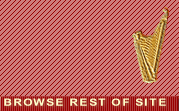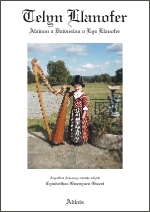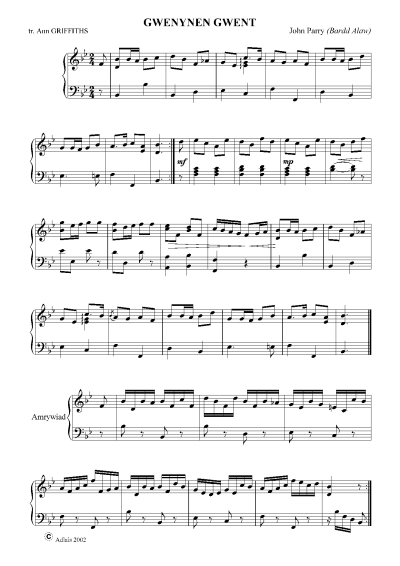 |
|||
| |
of Harp Music |
| © 2004-2025 ADLAIS |
| Telyn
Llanofer Welsh Airs and Dances from Llanover John Parry (Bardd Alaw 1776 - 1851) SB Gruffydd Richards (1854 - 1952) arr. Ann Griffiths |
return to previous page |
 |
Work: | Four works for solo harp |
| Catalogue No: | Adlais 040 | |
| ISMN: | 979-0-57032-005-9 | |
| Edition: | 2003 A4 stapled | |
| Suitable for: | Grade 5-6, Lever, Pedal or Triple Harp | |
| Price:: | £7.50 Go to shop | |
| Contents: | 1. Gwenynen Gwent - John Parry,
arr. Ann Griffiths 2. Llanover - John Parry, arr. Ann Griffiths 3. Rhif Wyth - SB Gruffydd Richards, arr. Ann Griffiths 4. Ril Llanover - trad. arr. Ann Griffiths |
| Telyn Llanover |
This special edition of Telyn Llanofer was made to celebrate the launch, on 12 October 2003, of Cymdeithas Arglwyddes Llanofer / The Lady Llanover Society. The rare Llanover triple harp featured on the cover, and on which some of the music in this collection may have been played, was made on the estate by one of Lady Llanover's harp makers. Pictured playing it is Lady Llanover's great-great-great-great grand-daughter, who is wearing an authentic costume, actually made for her ancestor, and worn by her in the late 1880s. Arranger's notes from the score: ‘Iaith enaid ar ei thannau' [Its
strings sound the language of the soul] Gwenynen Gwent, Lady Llanover, is, without doubt, the most important figure in the survival, the revival and today's resurgence of interest in the triple harp and its Welsh traditions. Indeed, without her, it is probable that the only triple harps still in existence today would be curious museum specimens, consigned to the air-conditioned silence of a glass case, and forever mute. For Lady Llanover, the strings of the triple harp sounded the language of the soul. That language, of course, was the Welsh language, and to Lady Llanover and her friends, the harp became a patriotic emblem, not only of the traditions and culture of Wales, but of Wales itself. It was in Brecon, at the Cymreigyddion Eisteddfod of 1826 that Augusta first met Thomas Price, 'Carnhuanawc', then vicar of Cwmdu, Breconshire - an eloquent advocate of all things Welsh, and in particular of the triple harp. It was at this same Eisteddfod that John Wood Jones of Dolgellau (1800-1844) won the silver harp awarded to the best harpist, and he was immediately engaged to come to Llanover as harper to the household. John Wood Jones was followed in this position by Thomas Gruffydd of Llangynidr (1815-1887), a partially blind harpist, and he in his turn was followed by his daughter, Susannah Berrington Gruffydd-Richards (1854 -1952). Her manuscript version of the dance, Rhif Wyth, given to me many years ago by a native of Llanover, is included here. Another fervent supporter of Lady Llanover's ideas and enthusiasms was the harpist and musician John Parry (Bardd Alaw) (1776-1851). He would come down to Abergavenny from London to adjudicate the harp competitions at the Eisteddfod. In Volume II of his collection entitled 'The Welsh Harper' (1848) he included a composition of his own entitled Gwenynen Gwent, where he says: 'Gwenynen Gwent The Bee of Gwent - is the Bardic Title given to the accomplished Lady of Sir Benjamin Hall, Bart., M.P., of Llanover Hall, near Abergavenny. Lady Hall's unremitting exertions in the promotion of Welsh Literature, Poetry & Music, reflect on her the highest honour. The doors of Llanover Hall are as freely opened to the tuneful Bards and Minstrels of Wales as they are to the most distinguished Literati of Europe, many of whom frequently partake of the hospitality of Sir Benjamin and Lady Hall; whose aim is to encourage and cherish the really national and native talent of the Principality.' Another of John Parry's compositions for the harp also included in this collection, and first published by Addison and Hodgson is entitled Llanofer. Telyn Llanofer is completed by the publication of an arrangement of the Llanover Reel. It is published as a tribute to Lady Llanover, and to commemorate the 200th anniversary of her birth on 21 March, 1802. A further aspect of Lady Llanover's influence in advancing the triple harp was her sponsorship of harp makers. Not only did she herself sponsor harp-making by commissioning instruments as prizes at the different Cymreigyddion Eisteddfodau held in Abergavenny, but she also persuaded her aristocratic friends to do the same. The favourite harp maker in the early days was Basset Jones, a harp maker based in Cardiff. It was he who made the triple harp won by the twelve-year-old John Thomas (Pencerdd Gwalia) - future official harpist to Queen Victoria - at the Abergavenny Eisteddfod of 1838, and it was also he who made the very ornate triple harp designed by Carnhuanawc and presented to the Prince of Wales in 1843. After Basset Jones's death, harps were made on the Llanover estate by estate workers. These included Abram Jeremiah (d.1885) and Elias Francis of 'Highmead', Coldbrook (1829-1911), who is reputed to have denuded the orchard at 'Highmead' of pear trees in order to provide the hard wood he needed for the construction of the necks of his harps. Few examples of Llanover-made triple harps now remain. A typical Llanover harp stood considerably higher than any harp by the famous eighteenth century maker John Richards or any harp by Basset Jones. The column was very tall, the back of the harp was coopered, and the tuning pins were probably made by the village blacksmith. The necks of Llanover harps were normally strengthened by the use of a shaped piece of iron which followed the curve of the neck and strengthened it, and by an iron insert into the column of the harp which helped maintain it upright. The harps were often decorated with carvings depicting the druidic symbols of acorns and oak leaves. A fascinating tradition records that the number of empty acorns in the carving on the harp's neck indicated the identity of the maker. The strings on Llanover triples are normally set so that the two outer parallel rows (tuned in unison with one another and thus able to produce the typical virtuosic-sounding doubled-note effect) have, respectively, 36 and 29 strings. It is the inner row of strings which gives the chromatic notes. © Ann Griffiths St David's Day 2002
|




